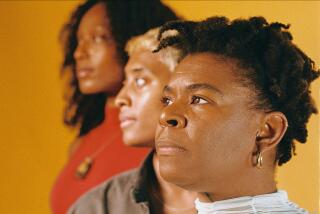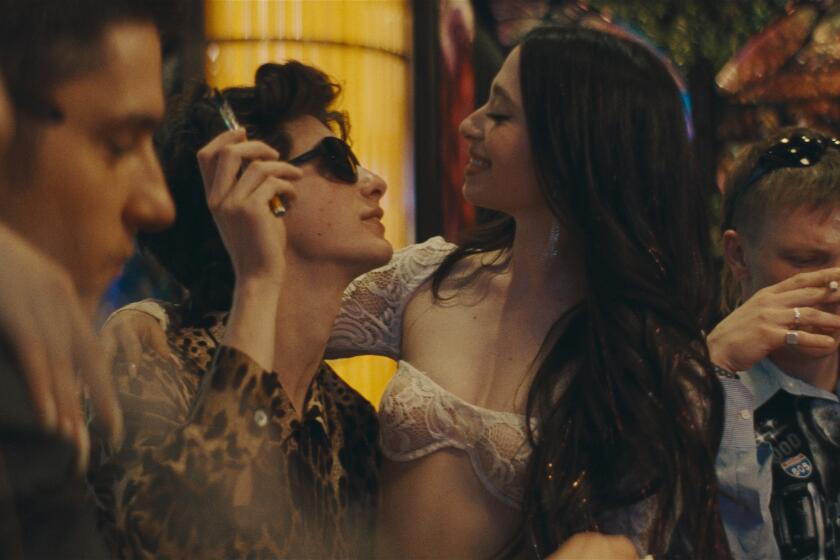New Voices Emerge to Tell the Story of Ordinary Americans
- Share via
“Boxes,” says Quentin Lee, “are the problem of our era.” The boxes he means are outdated categories--the rigid compartments that can no longer contain the complexity of our lives and selves.
“You’re lesbian, and I’m white and heterosexual, and he’s black . . . all these identities have become essential and stifling,” he says.
Lee is 27, a filmmaker, and gay. He is a Canadian citizen born and raised in Hong Kong who lives in a neighborhood with a substantial Central American population called Koreatown. In other words, as much as anyone, he is an ordinary Angeleno.
When Lee and his film school classmate Justin Lin decided to make a film pushing the limits of identity politics, all they had to do was point a camera at people like themselves. Their independently produced movie, “Shopping for Fangs,” is about Southern Californians struggling through the awkward period between college and commitments.
Choosing a familiar, universal theme was itself subversive, an assertion that being young, Asian American or gay influences one’s vision, but does not have to define it.
Lee and Lin shot their film in a place that is beyond the simple identity conflicts of the recent past, the San Gabriel Valley towns south of Pasadena.
In the 1980s and early in this decade, immigrants from Asia transformed places such as Monterey Park, San Gabriel and Alhambra, changing the racial makeup of schools and lining the main drag, Valley Boulevard, with ethnic-oriented businesses. Their arrival sparked English-only movements and complaints from older residents that the newcomers would never fit in.
Occasional ethnic squabbles still erupt, but the dust has mostly settled. The communities are beyond reacting to the “foreign-ness” of Asian people--people who now are entrenched in the area’s commercial, civic and cultural core, struggling with everyone else to forge a new kind of American community.
For young Asian Americans, especially those who immigrated at an early age, the San Gabriel Valley’s cafes and nightclubs are a kind of cultural lode star. Much of “Shopping for Fangs” uses the Go Go Cafe, a flashy Hong Kong-style late-night San Gabriel joint that serves club sandwiches and dim sum, with lots of Cantonese torch singing in the background.
It is a place where even kids who can’t understand the lyrics get the message, which Lee describes as: “It’s good for you to be Chinese! You should not look at it as something that causes [an identity] crisis.”
The cafe sits atop the giant San Gabriel Square shopping mall. It is kitschy on its own terms, in a brazen Asian nouveau riche way, as opposed to the hokey kitschiness of Chinatowns built to trap tourists.
“In old Chinatowns, every building looks like a temple to bring in the tourists. It’s nice to see a place that doesn’t have to do that to thrive. It’s empowering,” said Lin.
That self-assuredness is displayed by the film’s lead character, Trinh, a brash gun-toting waitress at the Go Go. She is a lesbian who wears a blond wig and sunglasses. Her more conflicted alter-ego is the character Katherine (an Anglicized derivation of Trinh), a vacuous, repressed San Marino housewife.
The characters are placed in San Gabriel and San Marino because those places, like the subjects, are part of L.A.’s multiracial mainstream, not an exotic backdrop like Chinatown.
*
Above the streets of the San Gabriel Valley, in the movie studios and newsrooms, the immigration waves that transformed Los Angeles in the last two decades have been assessed and described mainly by those reacting to it as natives.
Quentin Lee and Justin Lin represent new voices, those emerging from the children or adolescents who were part of those waves and are gathering the tools to tell their stories. Lee studied literature at UC Berkeley and Yale before going to UCLA film school, where he met Lin, 26, in the graduate program.
They say their work is political, just not overtly so.
“We don’t have to make another ‘Joy Luck Club.’ Simply by using Asian Americans in different genres, we’re bringing up issues of identity,” said Lin, who came to Buena Park with his family at age 9 and became an Eagle Scout while his folks supported the family with a fish-and-chips shop. “It’s liberating.”
*
There are striking similarities between today’s immigrants and those who shaped America during the great immigration of the beginning of the century.
When Justin Lin talks about being “liberated,” it echoes Irving Howe describing the Jewish intellectuals of the 1930s. They were, he wrote, “emancipated Jews who nevertheless refused to deny their Jewishness.”
Howe made that observation in his autobiography, “A Margin of Hope.” Quentin Lee has not heard of Howe, but in a marvelous coincidence calls his production company Margin Films.
The eras change, but the challenges remain in many ways the same.
Through “emancipation” from the immigrant milieu that had been the staple of Jewish writers before them, Howe and other children of immigrants broadened their influence on American intellectual life. But by maintaining links to their Jewishness, they also helped to emancipate America from its prevalent anti-Semitism.
Perhaps as more of Quentin Lee and Justin Lin’s peers emerge from the margins, they too will have a liberating effect on America, freeing us from some of the fear of newcomers that keeps us in boxes and reminding us, as Irving Howe once did, that “the rhythms of American culture” are “rhythms of shock, break and intrusion by alien roughnecks.”
More to Read
Only good movies
Get the Indie Focus newsletter, Mark Olsen's weekly guide to the world of cinema.
You may occasionally receive promotional content from the Los Angeles Times.










